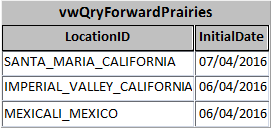Wind trajectories Related to Diamondback Moth (DBM) and
Aster Leafhopper Introductions
BACKGROUND:
Potential wind events capable of carrying insect pests from source areas
in the USA can be identified by following trajectories for air parcels through
time. High altitude air masses, originating from southern locations, frequently
move northerly to Canadian destinations. Insect pest species such as
Diamondback moth and Aster leafhoppers, traditionally unable to overwinter
above the 49th parallel, can utilize these air masses in the spring to move
north from Mexico and the United States (southern or Pacific northwest). Data
acquired from Environment Canada is compiled by Olfert et al. (AAFC-Saskatoon)
to track and model high altitude air masses in the spring with respect to
potential introductions of insect pests onto the Canadian prairies. Each week,
backward and forward trajectories are examined with respect to source and
destination in the following manner. The forward trajectories are prognostic (5
days into the future) based on forecast wind fields while the backward
trajectories are diagnostic and based on analyzed wind fields (5 days
previous).
THE WEEK OF APRIL 1-7, 2016: Wind trajectory data processing by
AAFC-Saskatoon Staff began in April.
Reverse Trajectories track arriving air masses back to their point of
origin while Forward Trajectories predict favourable winds expected to arrive
across the Canadian Prairies for the week of April 1-7, 2016:
Reverse trajectories (RT)
None to report this week.
Forward Trajectories (FT)
Trajectories crossing over California and Mexico are
projected to cross Alberta, Saskatchewan and Manitoba this week. Those involved with Diamondback moth pheromone trap monitoring will want to consider deploying their traps.
